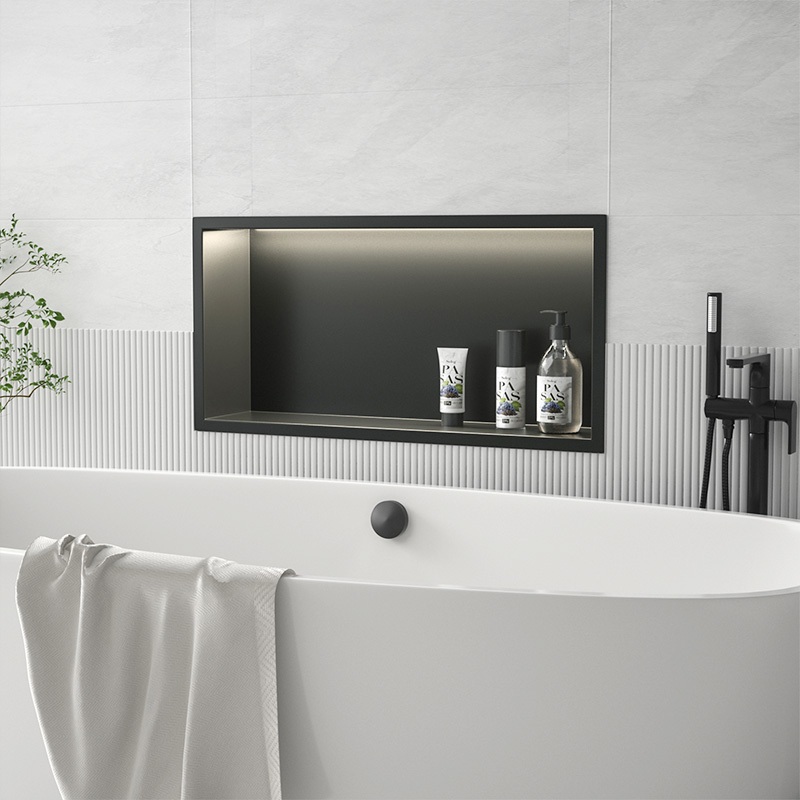How To Make A Niche in The Wall?
Creating a wall niche is one of the most practical ways to add depth, storage, and architectural beauty to a room. It serves both functional and decorative purposes, offering space for daily items or display accents. Whether you’re working on a bathroom remodel, a kitchen upgrade, or a hallway accent wall, the process requires planning, precision, and proper materials. This guide explains how to make a wall niche step by step, showing how to ensure it looks built-in, waterproof, and long-lasting.
1) Planning The Niche
Define its purpose
Before cutting the wall, determine how you’ll use the niche. For example, a shower niche needs to fit shampoo bottles, while a hallway niche may hold décor. The use determines size, height, and finish. A typical shower niche measures about 12–14 inches wide, 12–16 inches high, and 3.5–4 inches deep, positioned around 42–48 inches from the floor for easy reach. Decorative niches can vary widely depending on design goals.
Assess the wall structure
Locate wall studs using a stud finder and ensure you’re not cutting through load-bearing framing, pipes, or wiring. For non-bearing walls, you can remove a section between studs, but always inspect through small pilot holes to avoid damaging utilities. If the wall is structural, you may need additional framing or to shift the location.
Align with the tile layout
For tiled surfaces, especially in showers, align the niche height and width with the tile pattern so grout lines flow evenly into the opening. Planning ensures that tiles don’t require narrow cuts at the edges, which would look unprofessional.
Choose between custom-built or prefabricated
Two main methods exist:
Site-built niche — framed manually using studs, backer board, and waterproofing.
Prefabricated niche — ready-made units made from waterproof foam board, stainless steel, or PVC, like those from our Wall Niche Series, designed to fit standard 16-inch stud spacing.
Prefabricated models save time and guarantee clean geometry, ideal for large projects or remodels.
2) Preparing The Wall Opening
Mark and cut accurately
Once the ideal location is chosen, mark the niche’s outline with a pencil and level. Use a drywall saw to cut the shape. Avoid widening cuts until you’ve verified what’s inside the wall cavity.
Frame the opening
Install horizontal blocking between studs to form the top and bottom of the niche. Use 2x4 or 2x6 lumber, ensuring the opening remains plumb and square. The inside edges should align with the surface of the wallboard, allowing tiles or finishes to sit flush later.
Add supports for shelves
If you’re building a multi-tiered niche, install middle blocking to support internal shelves. It’s easier to integrate these supports before covering with cement board or drywall.
Select the correct substrate
In dry areas, moisture-resistant drywall can be sufficient, but for wet areas like showers, always use cement backer board or waterproof foam panels. These prevent water absorption and extend the niche’s lifespan.
Create a forward slope
To prevent water pooling, tilt the bottom panel slightly forward—about 1/4 inch per foot. This subtle angle ensures efficient drainage in showers or above tubs.
3) Installing The Niche
Prefabricated niche installation
Dry-fit the niche to check that it sits snugly between studs.
Fasten it securely using screws through the flange.
Seal all joints with waterproofing tape or membrane to connect it to the wall system.
Check slope for drainage if used in wet areas.
Finish with tiles or other wall materials flush to the face.
Prefabricated Wall Niches from our collection make this process faster. They come pre-sloped, waterproofed, and dimensionally precise, saving hours of on-site labor.
Custom-built niche installation
Frame the cavity with lumber and ensure everything is square.
Cover the inside with cement board, fastening it to the blocking and studs.
Waterproof using a sheet or liquid membrane. Extend it onto the surrounding wall for full protection.
Set the sill—use stone, porcelain, or solid surface materials to resist moisture.
Tile carefully, beginning with the back wall, followed by the sides, top, and bottom. Align grout joints for a seamless appearance.
Proper waterproofing is the most critical stage. A continuous membrane prevents leaks behind tile layers and keeps the niche maintenance-free for years.
4) Finishing And Detailing
Choose the edge style
There are several finishing options:
Mitered tile edges create a luxury, seamless transition.
Metal trims like L-profiles or square edge trims produce a minimalist look.
Picture-frame tile borders add a decorative frame effect.
Select one based on your room’s style. Consistent grout joint thickness and perfectly aligned corners define a professional installation.
Add a decorative back panel
The niche’s back is a focal point. Using mosaic, marble, or patterned tiles adds contrast and visual depth. In contemporary interiors, a single slab or same-color tile can make it look integrated and subtle.
Grout and seal
Use epoxy or polymer-modified grout in wet environments to resist water and mold. Fill joints completely, then apply color-matched silicone where planes meet—such as corners—to allow flexibility and avoid cracking.
Accessory integration
Consider practical upgrades: glass or stone shelves, LED lighting for display niches, or recessed soap holders. For illuminated niches, use waterproof low-voltage lighting rated for damp locations.
Inspection and clean-up
Before final cleaning, confirm there are no leaks or hollow spots. Use mild neutral cleaners; avoid harsh acids that can etch stone or grout. Proper finishing ensures a flawless appearance that enhances the overall wall design.
5) Dimensions, Placement, And Maintenance
Standard dimensions and locations
Below is a quick reference table for ideal niche sizes:
| Application | Width | Height | Depth | Placement |
|---|---|---|---|---|
| Shower single niche | 12–14 in | 12–16 in | 3.5–4 in | 42–48 in from floor |
| Double shower niche | 12–14 in | 24–28 in | 3.5–4 in | 40–48 in centerline |
| Bathtub wall | 18–24 in | 12–16 in | 4–5 in | End wall above tub edge |
| Kitchen backsplash | 16–20 in | 10–14 in | 3.5 in | Between upper and lower cabinets |
| Hallway display | 16–24 in | 18–30 in | 4–5 in | Eye level |
These measurements serve as general guidelines; you can adjust to fit the tile layout or product dimensions.
Avoid common mistakes
Flat bottoms in showers cause standing water and stains. Always maintain a slope.
Ignoring tile layout leads to awkward cuts or misaligned grout lines.
Skipping waterproofing is a recipe for moisture damage.
Inconsistent edges ruin visual balance; always measure and level precisely.
Maintenance tips
Clean the niche regularly with pH-neutral detergent.
Re-seal natural stone every 6–12 months to maintain luster.
Inspect caulk lines yearly; re-apply if shrinkage or cracking appears.
Keep shelves dry after use to prevent mildew buildup.
Avoid harsh chemicals or scrubbing pads that can damage finishes.
Following these small maintenance habits will keep your wall niche fresh and spotless for years.
6) When To Use Prefabricated Wall Niches
For professional contractors or fast-paced renovation projects, prefabricated wall niches provide consistent quality. Each unit comes with:
Integrated waterproofing, eliminating leaks.
Pre-set slopes for efficient drainage.
Exact fit between 16-inch studs without extra cutting.
Ready-to-tile surfaces, compatible with most adhesives.
They are especially ideal for multi-unit developments, hotel bathrooms, or tight timelines where uniform quality matters most. By choosing a prefabricated niche, you reduce labor costs while maintaining a flawless finish.
Choose Reliable Wall Niches For Quality Projects
If you want to simplify construction and ensure long-term durability, select prefabricated wall niches designed for both wet and dry areas. Our products feature high-density waterproof panels, smooth installation flanges, and multiple size options compatible with standard studs. They combine professional precision with modern style, making them suitable for residential and commercial installations alike.
A properly designed and installed niche enhances usability, keeps walls organized, and adds refined beauty to any space. With the correct materials, waterproofing, and finish, your wall niche will remain sturdy, elegant, and functional for many years to come.




